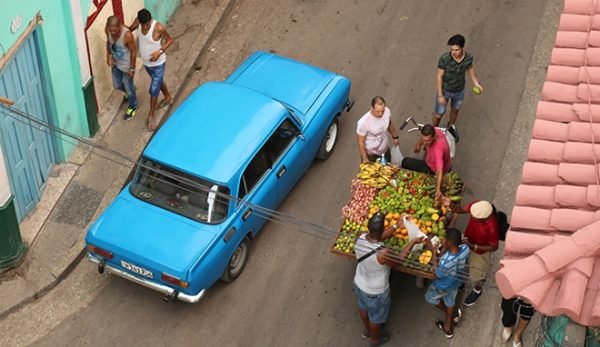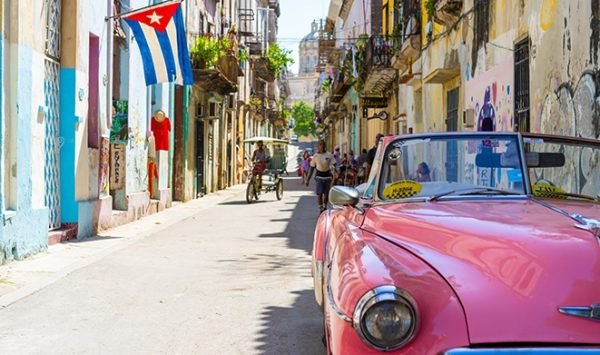Casas particulares, or casas for short, are the homes of local Cubans who rent rooms to visitors like a B&B. You can rent a room in a private home for an average of US$30 per night.
The best part of staying with a Cuban family is that you can have an authentically Cuban experience. You eat with them, hang out in their living room, play with their kids or pets. You’re treated like one of the family while you are there. That’s a lot more rewarding than staying at a sterile hotel.
It’s easy to book a casa. You can reserve on Airbnb or any number of similar online sites, though Airbnb often has the largest selections. You should pre-book a casa from home at least for your first night’s stay in Cuba. Once in Cuba you can book the following nights yourself either through your casa host or just by looking for a house with the casa sign (a blue anchor with a roof on a white background) and simply knocking on the door.
Otherwise, hostels will be your best option for saving money.
Prices per night range from around 5 to 15 CUC, though most are around 11 CUC.
The best places to eat in Cuba are paladares. These are privately owned (vs. government-owned) restaurants. There are all types of paladares, from high-end establishments in renovated mansions to hole-in-the-wall stands.
Traditional dishes you will find at paladares include arroz con pollo (chicken and rice), ropa vieja (shredded beef), and lechón (roast pork). Typical drinks include the classic mojito, daiquiri, and Cuba Libre. Fruit juices are also readily available. The local beers, Bucanero and Cristal, are very good.
Street vendors are also found throughout the country and offer little sandwiches, pizza, croquettes, pastries, and other snacks for 1 to 3 CUC. The food is not great, but it certainly is budget-friendly.
Transportation is likely to be your biggest expense, with taxis being the most common. Rule number one for getting around in Cuba is to negotiate before getting in. Tell the driver where you want to go, or show him in writing and ask how much (“¿Cuánto?”). Whatever the driver says, counter with a couple of CUCs lower. The drivers are used to this; they generally start at a higher rate, anticipating that they will end up with a lower fee.
Yellow taxis are government-run (vs. privately owned). These are used by tourists and tend to be the most expensive.

Coco-taxis are essentially motorcycles with a cover shaped to look like a yellow coconut (hence the name), and they are everywhere. They tend to be cheaper but can only take two people at a time.
Bici-taxis are rickshaw-like bicycles that’ll take you around Old Havana.
Another option is the colectivo, or collective taxi. These are cars that travel busy thoroughfares within city limits, picking up and dropping off people as they go along. A trip from one end of a busy, central street to the other, or anywhere in between, will cost about half a CUC. The taxi is shared with up to six people.
Buses are overcrowded, unreliable, and not air-conditioned but they are very cheap. They travel major routes mostly outside Old Havana.
Typical transportation costs:
Yellow government taxi: 10 CUC within city limits
Coco-taxi: 5 CUC within city limits; only fits 2 people
Bici-taxi: 2 CUC per person; only fits 2 people; not motorized
Collective taxi: Half a CUC per trip in a shared taxi
Bus: About 0.20 CUC
A fun way to explore a big city like Havana is by taking a tour in a classic American convertible from the ’50s, but at 40 to 50 CUC an hour, they aren’t very budget-friendly.

Internet access in Cuba is iffy. It is not offered everywhere, and where it is, it is unreliable.
The best way to stay connected is to purchase an internet connection card, sold in increments of 1 CUC per hour, at the local ETECSA, the Cuban government’s telecommunications office with branches all over the island. You use the login and password on the card to connect your phone or computer.
You can also purchase an internet connection card at most high-end hotels, but the cost can be as high at 7 CUC per hour, so purchasing your card at an ETECSA is a huge saving.
Once you have your card, find a location where you can connect. Most parks have connectivity, as do areas around ETECSA offices. Just look for groups of people huddled over their phones.
Higher-end hotels also offer Wi-Fi at outrageous fees.
If you don’t use up your internet time, the leftover will be saved on your card and you will be able to use it again.
A typical daily budget
For a typical day in Havana, Cuba’s most expensive city, you can expect to budget as follows:
Breakfast at your casa: 5 CUC
Street food snacks: 2–5 CUC
Lunch at a paladar: 5–7 CUC
Dinner at a paladar: 5–10 CUC
Alcoholic beverage: mojito: 2–3 CUC, beer: 2 CUC, rum: 5 CUC/bottle
Room in a casa: average 30 CUC
Intracity taxi: 2–10 CUC
Museum entrance fee: 2–8 CUC
Entrance fee to a music venue: free or 2–10 CUC
Internet connection card 1–2 CUC
To be on the safe side and leave yourself a little room to splurge, budget 100 CUC/day. Keep in mind you may want to purchase the world-famous cigars and rum. The local art you find at the many galleries around town may also appeal to you.
Traveling outside of Havana
When traveling outside Havana, you’ve got a couple of options. The most convenient and expensive is to reserve a taxi that will pick you up at your casa and deliver you door to door. Your casa host or hostel or hotel staff can arrange one for you.
Another option is the national bus service, which extends across the entire country. The buses are air-conditioned, and the prices are very reasonable. Prices from Havana to popular destinations are as follows:
Havana to Viñales: 12 CUC
Havana to Trinidad: 25 CUC
Havana to Varadero: 10 CUC
Havana to Santiago, on the far side of the island: 51 CUC
You need to purchase your tickets at the Viazul bus station at Avenida Independencia #101, at the corner of 19 de Mayo. The buses will take you to the bus stations in your destination city, which are generally in very central locations convenient to wherever you want to go.
There are car rental agencies throughout Cuba with which you can organize a self-drive tour. However, keep in mind that the roads outside Havana can be in very poor condition and difficult to navigate. With easy transportation within the big cities and convenient bus service between cities, a car rental may not be your most budget-friendly option.
